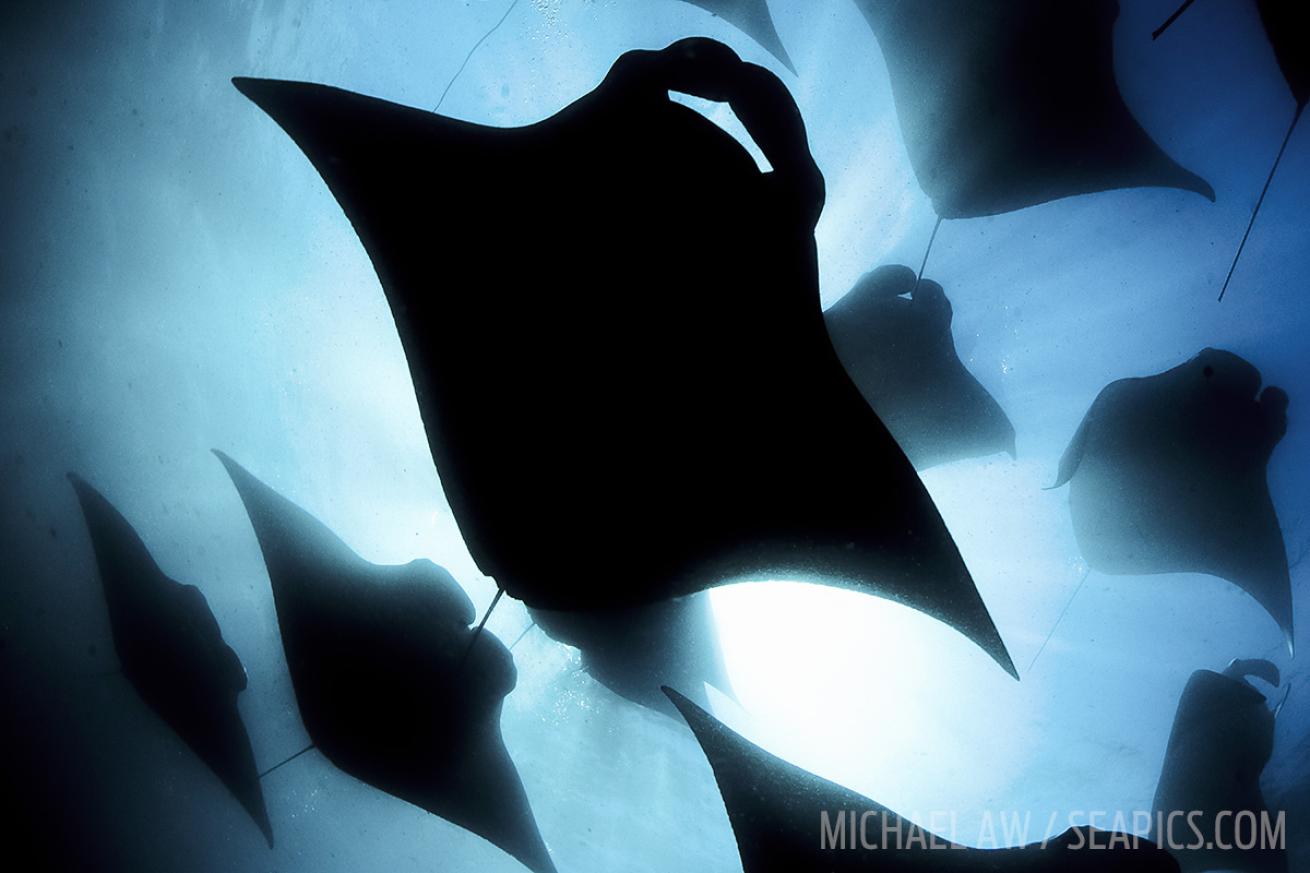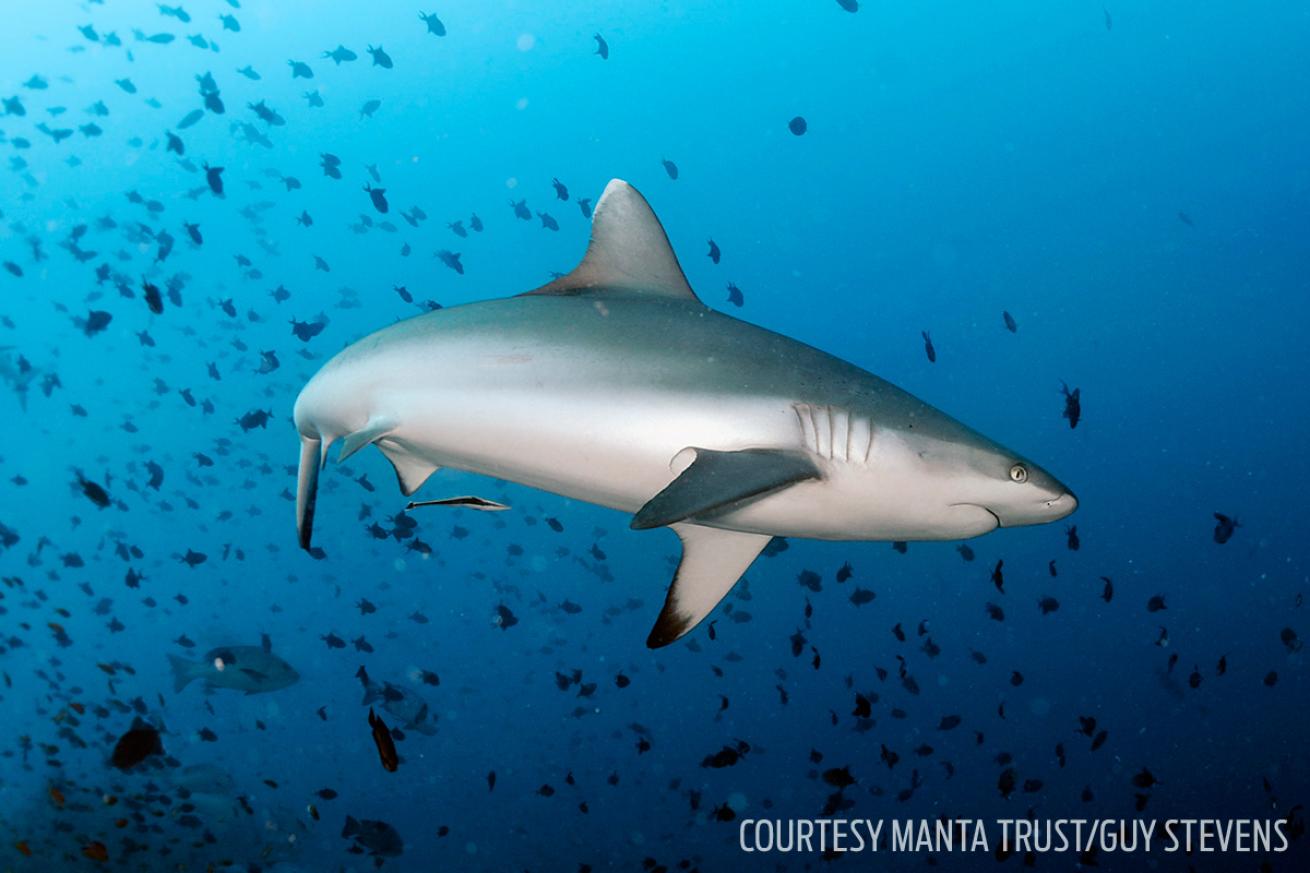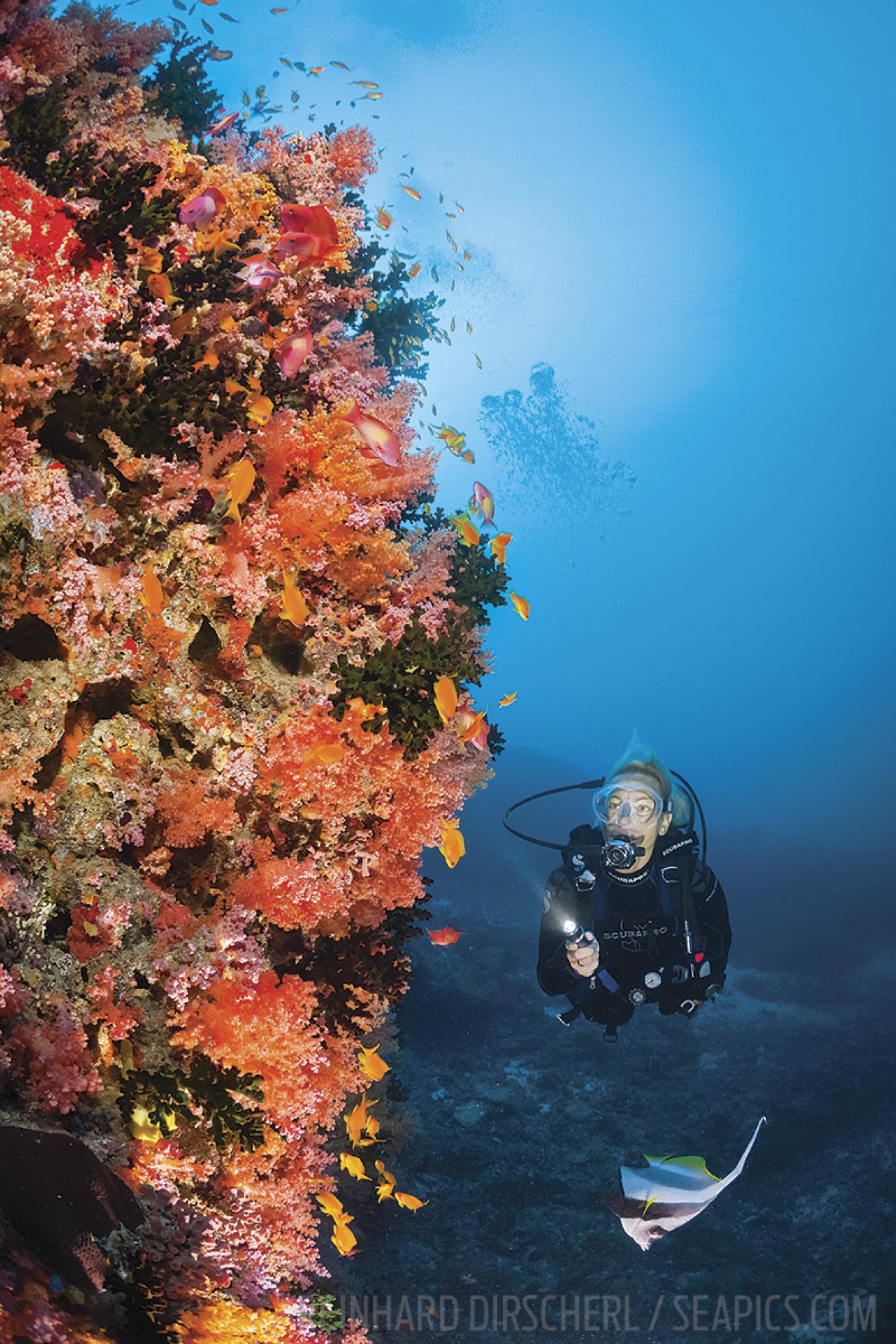Maldives Scuba Diving from the Four Seasons Explorer Liveaboard

Michael Aw/SeaPicsMEGA MANTAS
Diving the Maldives from Explorer yields unending thrills, including close encounters with mantas at various cleaning stations.
Top 5 Reasons to Dive the Maldives from the Four Seasons Explorer
1. The Mantas: In September, Four Seasons Explorer hosts expeditions of the Manta Trust that provide a chance to dive with an expert on mantas and marine biology.
2. Multiple Dive Sites: Many visitors spend their whole stay on one island; Explorer’s seven-night cruise visits five atolls.
3. Delicious Food: Yes, Explorer offers European, Asian and American cuisine, but try the Maldivian dishes, which include staples of tuna, rice and coconut prepared and spiced in endless variety.
4. The Ship: The 129-foot three-deck catamaran feels more like a luxury cruise ship than a liveaboard.
5. The Resorts: At Four Seasons Landaa Giraavaru and Kuda Huraa, tour marine-conservation centers, have a sandbar picnic, or get a massage at an over-water spa.
Maldives Scuba Diving Overview
When To Go: From December to April, drier, more-settled weather prevails, and viz can reach 130 feet. May to November brings more rain, and also current-swept plankton that draws aggregations of mantas and whale sharks.
Dive Conditions: Most dives are nitrox. Water temps in September range from 87 to 90 degrees F. Most days are two morning dives and one in the afternoon, but there are also night and sunrise dives. Most dives are conducted from a dhoni, a 55-foot tender with covered cabin and rooftop viewing area that accompanies Explorer.
Dive Operator: Four Seasons Explorer has an onboard PADI Five Star dive center, offering certification for Advanced Open Water and 12 specialties.
Price Tag: 2016 Manta Trust Expeditions are Sept. 1-8 and Sept. 15-22; 3-, 4- or 7-night cruises are available. Rates start at $2,550.
More Information: Four Seasons Maldives Cruise

Courtesy Manta Trust/Guy StevensSHARK SIGHTING
The nutrient-rich waters surrounding the Maldives sustain creatures big and small, from gray reefies to staggering coral reefs.
Maldives Scuba Diving Trip Report
From topside there had been nothing to distinguish this narrow pass from countless others we’d cruised by. On each side of the channel, low islands fringed with brilliant white beaches and movie-set coconut palms opened onto the emerald waters of a broad lagoon where small, tangled waves showed that the incoming tide had begun to stir.
But the dive crew of M/V Four Seasons Explorer promised us something special as we prepared to drop into the pass at Rasdhoo Madivaru.
At 60 feet we tucked in along the ridge of the reef, just out of the current rolling through the pass, to find that seemingly every fish of the reef was assembling before us. All the exotic varieties of snappers, triggers, surgeons and wrasses that I’d been struggling to identify were here in stunning abundance, nosing into the current, darting to snatch the plankton being swept into the lagoon.
Plankton wasn’t the only thing on the menu. Beefy gray sharks and lean whitetips hunted too, their streamlined bodies stemming the stiff current with an ease — the merest flick of a fin — that would make any diver jealous.
But it seemed they weren’t the most feared predators. While the smaller fish barely moved aside for the sharks, they fled in mass panic when a silvery dogtooth tuna ghosted through, its open jaws showing long, sharp teeth.
As hunters met with success, even the smallest fish would share in the reward, rushing in to snap up pieces of flesh amid the clouds of scales that tumbled along in the current.
Watching a school of eagle rays glide effortlessly overhead against the incoming tide, I heard the insistent rattling of a noisemaker that I knew was divemaster Sabrina Barde reinforcing her predive caution that we not get so caught up in the action that we forget to keep track of our gas supply.
Maldives Diving from the Four Seasons Explorer
No matter how many photos of the Maldives I’d seen — and I had studied plenty — they didn’t prepare me for my first sight of the real thing. For me that came on the morning flight in, when the clouds parted to reveal the sunlit skyline of the capital city of Male, perched so precariously on the edge of the transparent blue-green of the Indian Ocean that it looked as if it were floating.
Two hours later, my face was pressed to the window of the seaplane ferrying us northwest to Baa Atoll, where we would board Explorer. I was watching an endless chain of brilliant white beaches, emerald lagoons and cobalt reefs slip beneath us when we flew into a shower that bathed the scene below in a rainbow, the propeller carving elegant spiral contrails in the rain, giving the experience a dreamlike quality I blamed on jet lag induced by 18 hours of flying.
In the days to come, I never really shook that feeling. But one of my worries was misplaced — looking out over the atolls and lagoons stretched to the horizon I had thought, how do you even begin to explore places so far-flung and remote?
The answer, as it turned out, was waiting for us at the aptly named Explorer. The yacht served as the perfect base for our journey as we made our way through a trio of atolls and a series of dives that showed the amazing diversity of the Maldives.
We did drifts, stationary dives, dives in strong current, dives with no current, dives from 40 to 90 feet, and snorkels. (Hanifaru Bay, renowned for its manta aggregations, has snorkel-only rules enforced by rangers to protect the mantas.) Visibility was sometimes 100 feet or more, though on a memorable night dive with mantas in Ari Atoll, it was a souplike 20 feet because of the plankton that drew mantas swooping in out of the murk to pass within inches of us.
Soon enough I learned to have no expectations — except that I should expect to be surprised.
The lesson served well on my last day aboard when we searched for two hours for whale sharks off the south shore of Ari Atoll, our 47-foot wooden dhoni pitching through the swells, but found not a sign. We had just turned to head back to Explorer when a crew member shouted, “Whale!” It was a blue whale, and for the next hour it allowed us to tag along as it dove and blew every few minutes, until finally it curled its immense back, lifted its fluke clear of the water and dived deep, to the cheers of everyone on the boat.
Meeting the Manta Rays
Aboard Explorer with us was marine biologist and manta researcher Guy Stevens, who has deep ties to Explorer as well as to the Maldives.
After earning his degree as a marine biologist, Stevens left the U.K. for a job in the Maldives in 2003 as a biologist/dive guide aboard Explorer. He quickly fell under the spell of the islands and their manta rays, fascinated by their grace, their distinct personalities and how little was known about them.
Stevens founded the first full-time manta study, based at Four Seasons Landaa Giraavaru, which tracked manta encounters by identifying the animals based on their unique belly markings — nearly 4,000 Maldives mantas have now been identified — and went on to become the co-founder and chief executive of the Manta Trust, a research and conservation effort that operates in 16 countries.
Each September, Explorer hosts Manta Trust Expeditions with a representative from the trust — in our case, Stevens, giving us an opportunity to ask all the questions we had about the things we’d seen on our dives.

Reinhard Dirscherl/SeaPicsREEF ADVENTURE
The Explorer gives excellent opportunity to see reefs teeming with marine life of all kinds — like the exotic varieties of snappers, triggers, surgeons and wrasses that can be seen in after dropping into the pass at Rasdhoo Madivaru
As we ended our dive that day at the pass at Rasdhoo Madivaru, grudgingly slipping from our viewing spots along the reef to let the current pull us toward the lagoon for our safety stop and pickup, I thought of Stevens’ lecture in Explorer’s lounge a few nights earlier.
He had described the complex interplay of natural forces that are everywhere at work in the Maldives. Thousands of miles to the northeast, the heat of the Indian plains sends air rising over the mountains, fueling a low-pressure system that pulls in cooler ocean air, creating strong southwest winds that set in place a powerful seasonal current, bringing nutrient-rich waters from the deep up the steep slopes of the Maldives’ atolls and spilling into the shallow waters of the lagoons.
It’s hard to imagine a place more remote — more completely of the sea — than the islands of the Maldives, the world’s lowest country, none of it more than a few feet above sea level. Yet I’d seen those triggerfish in the pass at Rasdhoo getting fat on plankton delivered by the jet stream over the Himalayas.
No man is an island, the saying goes. Neither, it seems, is any place.










